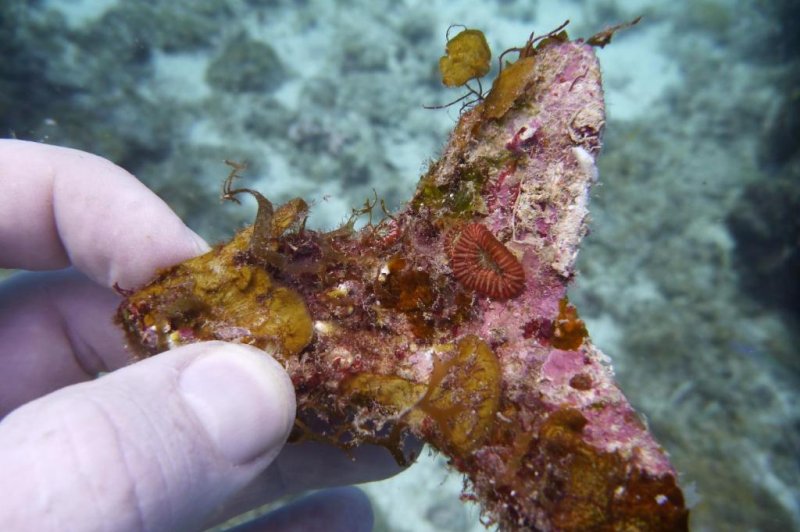A closeup image shows a SECORE Seeding Unit with a boulder brain coral growing near the substrate's center. Photo by Valérie Chamberland/SECORE International
Jan. 3 (UPI) -- Researchers with the nonprofit SECORE International have developed a new technique for planting coral. The method could enable reef restoration efforts at larger scales.
Currently, the process of replanting reefs is labor-intensive. Divers plant coral larvae or coral fragments individually. Often, such restoration efforts occur across a region no larger than 10,000 square feet. Meanwhile, coral degradation is occurring across thousands of square miles.
The new technique involves the stabilization of coral larvae in a specially-designed substrate. Instead of being individually planted by hand, the larvae-lined substrate attaches naturally to the reef. The substrate looks like a small, star-like anchor. It is wedged into crevices in the reef, allowing the corals to naturally sows themselves into the reef structure.
Using previous methods, the planting of 10,000 individual corals inside a 10,000 square-foot plot requires anywhere from several hundred to a few thousand person-hours of labor.
"Sowing the same number of corals could be achieved in less than 50 person-hours, a time saving of over 90 percent," Margaret Miller, research director for SECORE, said in a news release. "Additionally, material costs could be reduced up to one third, representing a substantial advance for future restoration work."
Scientists tested the new method using larvae released by golf ball corals, Favia fragum, in Curacao, the Caribbean island.
"Shortly after collection, we settled the coral larvae on specially designed tetrapod-shaped substrates made of cement," said lead researcher Valérie Chamberland.
By using naturally reproduced coral larvae, researchers can ensure healthy genetic diversity among newly planted corals. Once the larvae developed into coral polyps, researchers planted their substrate, called Seeding Units, on a test reef and tracked their growth.
"The specific shape of the tetrapod substrates allowed us to simply wedge the Seeding Units into natural crevices of the reef," Chamberland said. "Most Seeding Units were stable within few weeks, either secured in crevices or naturally cemented on the reef's framework."
The structure of the substrate helps ensure attachment to the existing reef, as well as create protective microhabitats where young corals are sheltered from predation.
Follow-up observations showed the restoration efforts were moderately successful, though competition from invading algal communities caused high levels of coral mortality.
"We settled between 20-30 larvae on each substrate to ideally have one coral established per Seeding Unit in the long term," Chamberland said. "After one year, more than half of the units were recovered and still harbored at least one coral, meeting this target required to eventually yield a successful restoration outcome."
Scientists are currently working on methods to reduce coral mortality and install substrates at larger scales as part of SECORE's Global Coral Restoration Project.
"If we are able to combine our new sowing approach with more effective coral larvae rearing techniques, which we are developing right now, costs of reef restoration could become comparable to the costs of existing mangrove and salt marsh restoration efforts," said Dirk Petersen, executive director of SECORE.
Researchers described their latest coral restoration efforts in a new paper published this week in the journal Scientific Reports.















